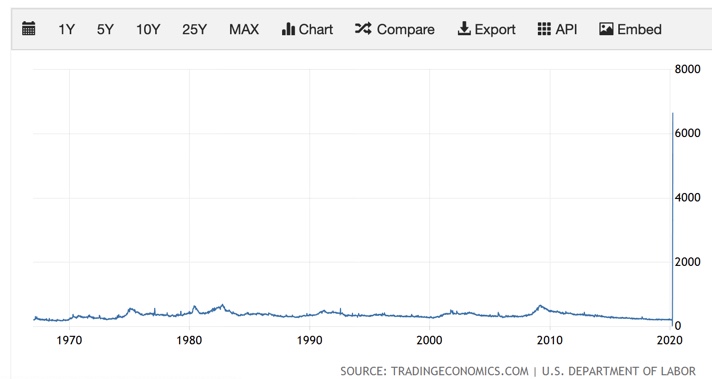Friday's jobs report showed the U.S. economy lost 701,000 jobs in March. But the merely awful data reflects mid-month payrolls — mostly before the coronavirus shutdown of the economy forced 10 million Americans to claim unemployment benefits in the past two weeks.

It's now beyond obvious that the coronavirus stock market crash in March ushered in recession 2020. Economists widely expect the deepest recession since demobilization from World War II, despite agressive policies to limit its damage. President Donald Trump signed a $2 trillion coronavirus rescue package last week.
The Federal Reserve has jumped into action with unlimited quantitative easing and a host of programs to help provide credit to businesses and households. But those efforts won't prevent an unprecedented shock to the economy. Slowing factories, plunging mortgage applications to buy a home, and a stunning drop in air travelers already are evident.
4.4% Unemployment Rate Before Coronavirus Shutdown
The unemployment rate rose to 4.4% from a half-century low of 3.5%. But economists expect unemployment rate to quickly spike well above 10%.
Employment in leisure and hospitality jobs sank by 459,000, mainly in food and drinking places. That's just a hint of the damage.
Still, it was the largest monthly increase in the unemployment rate since 1975.
On Thursday, the Department of Labor reported that 6.6 million Americans filed for unemployment benefits in the week of March 28. That doubled the prior week's upwardly revised 3.34 million claims for unemployment benefits. Claims for the March 28 week were nearly 10 times the pre-coronavirus record of 695,000 in 1982.
Over just the past two weeks, just under 10 million Americans filed for unemployment benefits, wiping out four years' of job growth. The latest week's number blew past even the highest Wall Street estimates of 5.5 million. Unadjusted for seasonal factors, 5.8 million people filed for benefits, with 878,000 in California.
The coronavirus rescue package opens jobless benefits to independent contractors and the self-employed, as well as for furloughed workers. But the change in eligibility suggests that those claims may not show up until next week's report.
ISM Manufacturing Gauge Falls; Home Purchases Dive
Data out Wednesday showed that the economic pain from the coronavirus recession is spreading. The Institute for Supply Management manufacturing survey index fell one point to 49.1, slipping into contraction territory below 50. A gauge of new orders tumbled 7.6 points to 42.2. The employment index slid 3.1 points to 43.8.
Meanwhile, the Mortgage Bankers Association reported its index of mortgage applications to buy a home fell 10% in the week ended March 27 from the prior week. Mortgage applications sank 24% from the same week a year ago.
Also, Transportation Security Administration data shows that on March 31, the number airport travelers processed through checkpoints fell 93% from a year ago: 146,000 vs. 2.026 million.
Coronavirus Shutdown: Tax Revenue Dives
A surge in coronavirus layoffs is now showing up in plunging federal tax revenues, an IBD analysis finds. Through February, federal taxes withheld from worker paychecks were growing more than 6% from a year ago. As coronavirus shutdowns infected the economy, growth slowed to roughly 4% through Friday, March 20. Then last week's data through Thursday, March 26, showed withheld taxes down 0.5% from a year ago.
Even worse, withheld taxes from Tuesday through Thursday of last week plunged 10% from a year ago. That's a bigger drop than at any time during the 2007-2009 recession.
However, there are important caveats. The tax data can be lumpy, especially at the end of March, which coincides with bonus payments. The depth of the plunge won't become evident for another week or two.
Coronavirus Shutdown: Economic Activity Collapses
UBS Evidence Lab data provide an indication of the impact of the coronavirus shutdown. In the U.S., hotel occupancy fell 58% last week from precrisis levels. Auto sales were running 45% below normal. ShowingTime says for-sale home showings have fallen 53%. Restaurant spending was down 37%. Retail sales, excluding autos and gas, were 18% below normal, UBS says. Traffic congestion has shrunk by 75% from a year ago.
In general, the hit to consumption has been sharper than the hit to manufacturing. Texas may be an exception amid a collapse in oil prices. The Dallas Fed's Texas manufacturing survey index plunged to -70 from 1.2 in March. That's the lowest in the survey's history back to 2004.
The IHS Markit survey for March showed eurozone business activity plunged to 44.5 from 49.2. The eurozone survey began in 1998. The overall activity gauge tumbled to 31.4 in March from 51.6 in February. Service-sector activity dived to 28.4 from 52.6. Readings below the neutral 50 level reflect contracting activity.
Read More on: https://www.investors.com/news/economy/coronavirus-shutdown-jobs-report-jobless-benefits/
https://klse.i3investor.com/blogs/moneymoney/2020-04-04-story-h1485790438-US_Coronavirus_Shutdown_Awful_Jobs_Report_Another_9_3_Million_Claiming_.jsp
